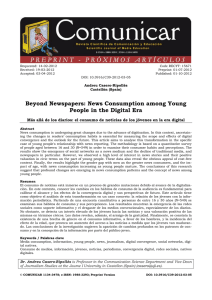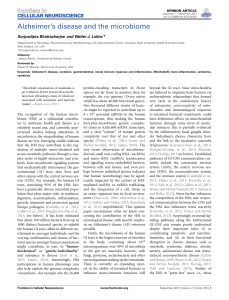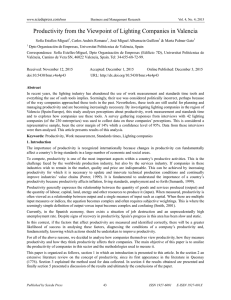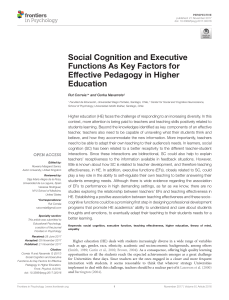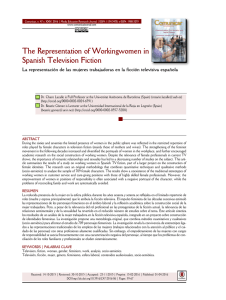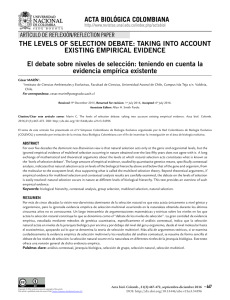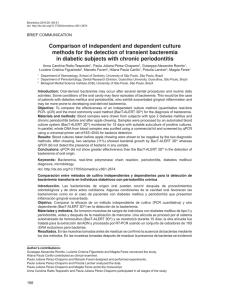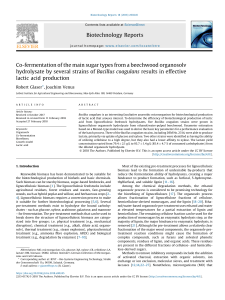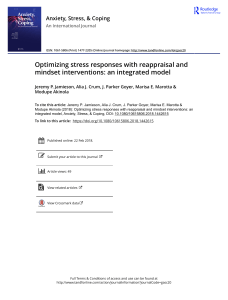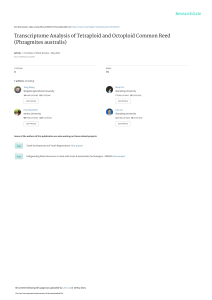Educating Teens about the Risks on Social Network Sites. An
Anuncio
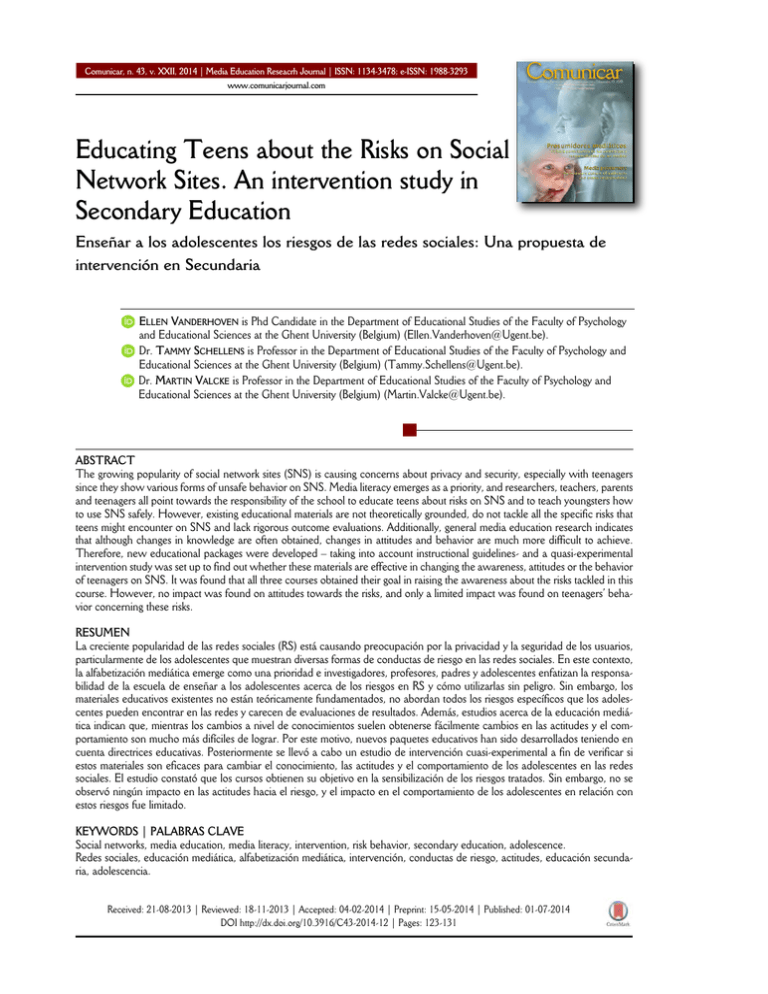
Comunicar, n. 43, v. XXII, 2014 | Media Education Reseacrh Journal | ISSN: 1134-3478; e-ISSN: 1988-3293 www.comunicarjournal.com Educating Teens about the Risks on Social Network Sites. An intervention study in Secondary Education Enseñar a los adolescentes los riesgos de las redes sociales: Una propuesta de intervención en Secundaria ELLEN VANDERHOVEN is Phd Candidate in the Department of Educational Studies of the Faculty of Psychology and Educational Sciences at the Ghent University (Belgium) ([email protected]). Dr. TAMMY SCHELLENS is Professor in the Department of Educational Studies of the Faculty of Psychology and Educational Sciences at the Ghent University (Belgium) ([email protected]). Dr. MARTIN VALCKE is Professor in the Department of Educational Studies of the Faculty of Psychology and Educational Sciences at the Ghent University (Belgium) ([email protected]). ABSTRACT The growing popularity of social network sites (SNS) is causing concerns about privacy and security, especially with teenagers since they show various forms of unsafe behavior on SNS. Media literacy emerges as a priority, and researchers, teachers, parents and teenagers all point towards the responsibility of the school to educate teens about risks on SNS and to teach youngsters how to use SNS safely. However, existing educational materials are not theoretically grounded, do not tackle all the specific risks that teens might encounter on SNS and lack rigorous outcome evaluations. Additionally, general media education research indicates that although changes in knowledge are often obtained, changes in attitudes and behavior are much more difficult to achieve. Therefore, new educational packages were developed – taking into account instructional guidelines- and a quasi-experimental intervention study was set up to find out whether these materials are effective in changing the awareness, attitudes or the behavior of teenagers on SNS. It was found that all three courses obtained their goal in raising the awareness about the risks tackled in this course. However, no impact was found on attitudes towards the risks, and only a limited impact was found on teenagers’ behavior concerning these risks. RESUMEN La creciente popularidad de las redes sociales (RS) está causando preocupación por la privacidad y la seguridad de los usuarios, particularmente de los adolescentes que muestran diversas formas de conductas de riesgo en las redes sociales. En este contexto, la alfabetización mediática emerge como una prioridad e investigadores, profesores, padres y adolescentes enfatizan la responsabilidad de la escuela de enseñar a los adolescentes acerca de los riesgos en RS y cómo utilizarlas sin peligro. Sin embargo, los materiales educativos existentes no están teóricamente fundamentados, no abordan todos los riesgos específicos que los adolescentes pueden encontrar en las redes y carecen de evaluaciones de resultados. Además, estudios acerca de la educación mediática indican que, mientras los cambios a nivel de conocimientos suelen obtenerse fácilmente cambios en las actitudes y el comportamiento son mucho más difíciles de lograr. Por este motivo, nuevos paquetes educativos han sido desarrollados teniendo en cuenta directrices educativas. Posteriormente se llevó a cabo un estudio de intervención cuasi-experimental a fin de verificar si estos materiales son eficaces para cambiar el conocimiento, las actitudes y el comportamiento de los adolescentes en las redes sociales. El estudio constató que los cursos obtienen su objetivo en la sensibilización de los riesgos tratados. Sin embargo, no se observó ningún impacto en las actitudes hacia el riesgo, y el impacto en el comportamiento de los adolescentes en relación con estos riesgos fue limitado. KEYWORDS | PALABRAS CLAVE Social networks, media education, media literacy, intervention, risk behavior, secondary education, adolescence. Redes sociales, educación mediática, alfabetización mediática, intervención, conductas de riesgo, actitudes, educación secundaria, adolescencia. Received: 21-08-2013 | Reviewed: 18-11-2013 | Accepted: 04-02-2014 | Preprint: 15-05-2014 | Published: 01-07-2014 DOI http://dx.doi.org/10.3916/C43-2014-12 | Pages: 123-131 Comunicar, 43, XXII, 2014 124 1. Introduction Almost everywhere around the world, teenagers form one of the main user groups of social network sites (SNS). For instance, in July 2012, about one third of the Facebook users in the US, Australia, Brazil and Belgium were under 24 years old (checkfacebook.com). The new generation of participatory network technologies provides individuals with a platform for sophisticated online interaction. Active participation of media audiences has become a core characteristic of the 21st century and therefore the meaning of media literacy has evolved. While it traditionally referred to the ability to analyze and appreciate literature, the focus has been enlarged, and is now this includes interactive exploration of the internet and the critical use of social media and social network sites is shortened everywhere else. Livingstone (2004a) therefore describes media literacy in terms of four skills, as the ability to access, analyse, evaluate and create messages across a variety of contexts. It has been found that while children are good at accessing and finding things on the internet, they are not as good in avoiding some of the risks posed to them by the internet (Livingstone, 2004b). 1.1. Risks on SNS The categories of risks teenagers face on a SNS, are broadly the same as those they face on the internet in general, summarized by De Moor and colleagues (2008). There are three different categories of risks. The first one describes the content risks. A typical example of provocative content teenagers might come across on SNS are hate-messages. These messages can be quite direct, like in an aggressive status-update or post on someone’s wall, but they can also be indirect, e.g. by joining hate groups. Teenagers also need to develop critical skills, to judge the reliability of information. The wrong information that might appear on SNS can be intentional, such as gossip posted by other users, or unintentional. The latter can happen when someone posts a joke that can be misunderstood as real information. Typical examples are articles out of satirical journals, posted on a social network site wall. The second category of risks includes contact risks, that is risks that find their source in the fact that SNS can be used to communicate and have contact with others (Lange, 2007). Next to instant messaging, SNS are the most popular media used for cyberbullying (Livingstone, Haddon, Görzig & Olafsson, 2011), by using the chat-function, by posting hurtful messages on ones profile or by starting hateful group pages. Additionally, they can also be used for sexual solicita- tion, as is seen in the process of grooming, where an adult with sexual intentions manages to establish a relationship with a minor by using the internet (Choo, 2009). Moreover, users face privacy risks, since they post a lot of personal information online (Almansa, Fonseca & Castillo, 2013; Livingstone & al., 2011). Additionally, 29% of the teens sustain a public profile or do not know about their privacy settings and 28% opt for partially private settings so that friends-offriends can see their page (Livingstone & al., 2011). The third category of risks contains the commercial risks. These include the commercial misuse of personal data. Information can be shared with third companies via applications, and user behavior can be tracked in order to provide targeted advertisements and social advertisement (Debatin, Lovejoy, Horn & Hughes, 2009). All these risks form a threat, since research indicates that exposure to online risks causes harm and negative experiences in a significant amount of cases (Livingstone e.a., 2011; Mcgivern & Noret, 2011). Internet harassment is seen as a significant public health issue, with aggressors facing multiple psychosocial challenges including poor parent-child relationships, substance use, and delinquency (Ybarra & Mitchell, 2004). Furthermore, some theories predict that young teenagers are less likely to recognize the risks and future consequences of their decisions (Lewis, 1981). Additionally, it was found that they have a harder time controlling their impulses and have higher thrill seeking and disinhibition scores than adults (Cauffman & Steinberg, 2000). This could increase risk taking by teens (Gruber, 2001), especially since posting pictures and interests helps in building and revealing one’s identity (Hum & al., 2011; Lange, 2007; Liu, 2007). 1.2. The role of school education Many authors emphasized the role of school education in raising awareness about these online risks (Patchin & Hinduja, 2010; Tejedor & Pulido, 2012). Schools appear to be ideally placed for online safety education, since they reach almost all the teenagers at the same time (Safer Internet Programme, 2009), making positive peer influences possible (Christofides, Muise & Desmarais, 2012). However, while the topic of online safety has been formally included in school curricula, the implementation is inconsistent (Safer Internet Programme, 2009) and although a variety of educational packages about safety on SNS has been developed (e.g., Insafe, 2014), most of the packages focus on Internet safety in general, and therefore lack focus on some of the specific risks that accompany the © ISSN: 1134-3478 • e-ISSN: 1988-3293 • Pages 123-131 use of SNS (e.g., social advertising, impact of hateTherefore, educational materials with regard to teenamessages and selling of personal data to third compagers safety on SNS actually are aiming at raising awanies). The packages that focus on risks on SNS, do reness about risks on SNS, raising care about the risks not tackle all of the above mentioned categories of on SNS and finally on making their behavior safer on risks, but often focus on privacy risks, cyberbullying or SNS. ‘wrong information’ (Del Rey, Casas & Ortega, 2012; Vanderhoven, Schellens & Valcke, 2014). Additional1.3. Purpose of the current study ly, there often is no theoretical base for the materials, As mentioned in section 1.2, the existing materials nor any outcome evaluation (Mishna, Cook, Saini, about online safety do not tackle all the categories of Wu & MacFadden, 2010; Vanderhoven & al., 2014). risks as described in section 1.1. Moreover, they do Indeed, very few studies are set up to evaluate the not focus on specific risks that are typical for the use of impact of online safety programs, making use of a control group and a quantitative data With regard to the risks on SNS, more research is needed collection approach (Del Rey, Casas & Ortega, 2012). to find the critical factors to change unsafe behavior and to It should be noted that quantitative intervention studevelop materials that can obtain all the goals that were set dies in the field of general out. Ideally, this research will follow a design-based media literacy education typically only find that intervenapproach, that is starting from the practical problems tions increase knowledge about the specific topic of the observed (e.g. unsafe behavior), and using iterative cycles course (Martens, 2010; Mishof testing of solutions in practice. na & al., 2010), while media literacy programs often aim to change attitudes and behavior as well. Nevertheless, attitudes and behavior are commonly not measured and if meaSNS. Therefore, new packages were developed sured, changes are often not found (Cantor & Wilson, covering all categories of risks and taking into account 2003; Duran e.a., 2008; Mishna & al., 2010). some instructional guidelines. The goal of these packaStill, when it comes to education about the risks on ges was not only that teenagers would be more aware SNS, one should look beyond mere cognitive learning. of the risks, but also that they would care about them Raising awareness about the risks on SNS is a first and that they would behave more carefully on SNS goal, but it would be most desirable to obtain a decreafter following the course. ase of risky behavior as well. The transtheoretical To verify whether these goals were obtained, a model of behavior change (Prochaska, DiClemente & quasi-experimental study was set up in which these Norcross, 1992) states in this context that there are packages were implemented and evaluated in authenfive stages in behavioral change. The first stage is the tic classroom settings. In contrast to some previous precontemplation stage, where individuals are unawaintervention research where researchers were actively re or underaware of the problem. A second stage is a involved in the intervention (Del Rey & al., 2012), teacontemplation stage, in which people recognize that a chers were responsible for guiding the intervention to problem exists. The third stage is a preparation phase, assure external validity. The following research quesin which action (stage four) is prepared. Finally, when tion was put forth: does an intervention about content, the action is maintained, people arrive in the fifth and contact or commercial risks have an impact on the last stage. Considering this model, if we want to chanawareness, attitudes and/or behavior of teenagers with ge the behavior of teenagers whose online behavior is regard to these risks? unsafe, we first need to make sure that they are in a contemplation stage (i.e., that they recognize the pro2. Material and methods blem). We might state that this ‘recognition’ contains a 2.1. The design of educational packages logic-based aspect (awareness of the problem) and an Three packages were developed: one about conemotional-based aspect (care about the problem). tent risks, one about contact risks and one about com© ISSN: 1134-3478 • e-ISSN: 1988-3293 • Pages 123-131 Comunicar, 43, XXII, 2014 125 Comunicar, 43, XXII, 2014 126 mercial risks. The exercises in the courses are a selecgiven, such as «Companies cannot gather my personal tion of exercises used in existing materials (Insafe, information using my profile on a SNS» in the course 2014), narrowing the course to one hour to satisfy the about commercial risks. Students agree or disagree need of teachers to limit the duration of the lessons using green and red cards. Answers are discussed guiand the work load (Vanderhoven & al., 2014). Some ded by the teacher. exercises were adjusted through small changes to assu5) Theory. Some real-life examples are discussed. re complete coverage of the different risks and to All the necessary information is summarized. satisfy some instructional guidelines drawn from constructivism, which is currently the leading theory in the 2.2. A quasi-experimental evaluation study field of learning sciences (Duffy & Cunningham, 2.2.1. Design and Participants 1996). Figure 1 shows how these principles are inteA pretest – posttest design was used, with one grated in the course. control condition and three experimental conditions, Every package consisted of a syllabus for the pupils as depicted in figure 2. A total of 123 classes participaand a manual for the teacher. This manual contained ted in the study, involving 2071 pupils between 11 background information and described in detail the and 19 years old (M=15.06, SD=1.87). learning goals and the steps of the course: 1) Introduction. The subject is introduced to the 2.2.2. Procedure pupils by the teacher, using the summary of risks (De To assure external validity, an authentic class Moor & al., 2008). situation with the regular teacher giving the lesson 2) Two-by-two exercise. Students receive a simuusing the detailed instructions in the manual for tealated ‘worst-case scenario’ SNS-profile on paper and chers and the syllabus for students- was necessary. have to fill in questions about the profile together with Therefore, only after teachers agreed to cooperate in a peer. The questions were different for the three different packages, scaffolding the pupils towards the different existing risks on the profile. As an example, the course about contact risks contained a question «Do you see any signs of bullying, offensive comments or hurtful information? Where?». Different aspects of the profile could be mentioned as an answer to this question, such as the fact that the person joined a group «I hate my math-teacher and there is a status-update stating ‘Haha, Caroline made a fool out of herself today, again. She’s such a loser’». 3) Class discussion. Answers of the exercise are discussed, guided by the teacher. 4) Voting cards. Figure 1. Instructional guidelines derived from constructivism and how they are applied Different statements with in the developed materials. regard to the specific con- (1) Duffy & Cunningham (1996), (2) Wood, Bruner & Ross (1976), (3)(Snowman, McCown & Biehler, tent of the course are 2008), (4) Kafai & Resnick (1996), (5) Mayer & Anderson (1992), (6) Rittle-Johnson & Koedinger (2002). © ISSN: 1134-3478 • e-ISSN: 1988-3293 • Pages 123-131 the research were students given the link to the online pretest. Approximately one week after they filled in the first survey, the course was given in the experimental conditions. Every class participated in one course about one subject. After they followed the course, pupils received the link to the posttest. Pupils in the control condition did not follow any course, but they received the link to the posttest at the same time as the pupils in the experimental conditions. 2.2.3. Measures The pre- and posttest survey measured nine dependent variables: awareness, attitudes and behavior towards content, contact and commercial risks. These scales were conceptually based on the summary of risks as described by De Moor and colleagues (2008). If available, operationalizations of different risks were based on existing surveys (Hoy & Milne, 2010; Vanderhoven, Schellens & Valcke, 2013). In table 1 all variables are shown with their meaning and Cronbach’s alpha indicating the reliability of the scale. Additionally, a direct binary measure of behavioral change was conducted by the question «Did you change anything on your profile since the previous questionnaire?». If answered affirmatively, an open question about what they changed exactly gave us more qualitative insight into the type of behavioral change. 2.2.4. Analysis Since our data has a hierarchical structure, Multilevel Modeling (MLM) with a two-level structure was used: pupils (level 1) are nested within classes (level 2). MLM also allows us to differentiate between the variance in posttest scores on classroom-level (caused by specific classroom characteristics, such as teaching style) and on individual level (independent of classroom differences). This is important given the implementation in authentic classroom settings, with the regular teacher giving the course. Because a multiple testing correction was appropriate in this MLM (Bender & Lange, 2001) a Bonferroni-correction was applied to the significance level α=0.05, resulting in a conservative significance of effects at the level α=0.006. For every dependent variable, we tested a model with pretest scores as a covariate and the intervention as a predictor (with the control condition as a referen© ISSN: 1134-3478 • e-ISSN: 1988-3293 • Pages 123-131 Comunicar, 43, XXII, 2014 127 Figure 2. Pretest - posttest design with four conditions. ce category). Therefore, estimates of the courses (as represented in table 2) give the difference in posttestscore on the dependent variable for pupils who followed this specific course compared to those who did not follow a course, when controlled for pretest scores. χ#-tests indicate whether the model is significantly better than a model without predictor. 3. Results 3.1. Awareness A significant between-class variance could be observed for all three awareness variables on the posttest scores (σ2u0, on average 13% of the total variance), indicating that the multilevel approach is needed. Second, the results show that the intervention is a significant predictor of all three awareness-variables. Indeed, a positive impact of the given courses on awareness can be observed: a course on content risks or contact risks has positive effects on the awareness of both those risks and a course on commercial risks has a strong positive influence on the awareness of commercial risks. Moreover, no significant between-class variance is left, indicating that the initial between-class variance can be fully explained by the condition that classes were assigned to. This also implies that there are no important other predictors left of the posttest scores on class-level, such as teaching style, or differences in what has been said during class discussions. The cross-effects between the course on content risks and the course on contact risks on the awareness about contact and content risks respectively, can be explained by the overlap in the courses and the risks. For example, cyberbullying and sexual solicitation can be seen as ‘shocking’, and therefore be categorized under contact as well as under content risks. However, commercial risks are totally different from the Comunicar, 43, XXII, 2014 128 other two categories, and therefore knowledge about these risks can only be influenced by teaching about these risks in particular, as is reflected in our results. 3.2. Attitudes Considering the measured attitudes, again a between-class variance was observed on the three different posttest scores (on average 16% of the total variance), indicating the need for a multilevel approach. Yet, there seems to be no impact of the courses on pupils’ attitudes whatsoever (non significant model tests). However, the mean scores over conditions, when controlling for pretestscores, are moderate (ranging from 4.79 to 5.23 on a 7-point Likert scale). This indicates that teenagers do care about the risks at least to some extent, independently of the courses, so that a change in behavior might still be possible. 3.3. Behavior Once again, significant between-class variance on all three behavioral variables (on average 12% of the total variance) shows that there were important differences between classes, and that a multi-level approach is required. With regard to pupils’ behavior, the course on contact risks has a positive impact on teenagers’ behavior concerning content risks and the course on content risks has a positive impact on teenagers’ behavior concerning contact risks. Although there is a lack of significant direct effects, it should be noted that the direct effect of the course on content risks on behavior with regard to content risks is marginally significant (p=.007). Furthermore, as stated in section 3.1, the overlap between the courses on content and contact risks can result in cross-content effects on the different risks. There seems to be no impact of the courses on pupils’ behavior with regard to commercial risks. These results indicate that the given courses do not fully obtain the goal of changing behavior. Still, if we analyze the answers to the question whether they changed anything on their profile (a more direct but also more specific measure of behavior), we do find some differences. In the control group, 7% of the pupils indicated having changed something on their profile, implying that even a survey encouraged some teenagers to check and change their profile. However, of those who followed a course, significantly more pupils changed something (16%, χ#=18.30, p<.001). Answers to the open question of what exactly they changed give us more insight in this information. The results of the content-analysis of these open questions can be found in table 3. As can be expected, when pupils had a course on content risks, they mainly change privacy-settings and the content of their profile (pictures, interests, personal information). When they followed a course on contact risks, they mostly change their privacy-settings and their personal information (including contact information). Participants of the course on commercial risks mostly changed their privacy-settings and their account-settings, protecting themselves against commercial risks. These results indicate that all courses – including the course on commercial risks- had an impact on the behavior of a significant amount of teenagers. Still, it should be noted that a lot of teenagers who did receive a course, reported that they did not change anything. 4. Discussion and conclusion It was found that all three newly developed courses obtained their goal in raising awareness about the risks tackled in this course. However, no impact was found on attitudes towards the risks, and only a limited impact was found on teenagers’ behavior concerning these risks. The lack of consistent impact on attitudes and behavior is an observation regularly found in general media education (Duran & al., 2008). In this particular case, there are several possible explanations. First of all, the given courses were short-term interventions, in the form of a one-hour class. The courses were organized this way to limit the workload of teachers, who reported not having a lot of time to spend on the topic (Vanderhoven & al., 2014). Although it was found that even short-term interventions can change online behavior with adolescents of 18 to 20 years old (Moreno & al., 2009), a more long term intervention might be needed to observe behavior changes with younger teenagers. Indeed, research in the field of prevention © ISSN: 1134-3478 • e-ISSN: 1988-3293 • Pages 123-131 Comunicar, 43, XXII, 2014 129 Note. * indicates significant difference in total change compared to control group. * p<.05, **p<.006, ***p<.001. shows that campaigns need to be appropriately weighted to be effective (Nation & al., 2003). Therefore, additional lessons might be needed to observe a stronger change in behavior. Second, it might be possible that attitudes and behavior need more time to change, independently of the duration of the course. In this case, it is not that raising awareness is not enough to change behavior, but that this process takes a longer time to be observed. The posttest was conducted approximately one week after the course. Maybe changes in attitudes and behavior could only be revealed later in time. Further research including retention tests should point this out. Third, it is interesting to look at different theories about behavior, such as the theory of planned behavior (Ajzen, 1991). Following this theory, behavior is predicted by the attitudes towards this behavior, the social norm and perceived behavior control. One of the predictions of this theory is that the opinion of significant others has an important impact on one’s behavior. Because of peer pressure, important instructional strategies to increase knowledge such as collaborative learning might be counterproductive in changing behavior. The same reasoning might be applicable on the other instructional guidelines that were taken into account when developing the materials. These guidelines might only lead to better knowledge-construction, which is often the most important outcome of classroom teaching, and might not be adequate to change behavior. Despite the lack of impact on attitudes, and the limited impact on behavior, our findings show that education about the risks on SNS is not pointless. The materials developed can be used in practice to raise the awareness about the risks among teenagers in secondary schools. Considering the transtheoretical model of behavior change (Prochaska & al., 1992) described in section 1.2, this is a first step to behavioral © ISSN: 1134-3478 • e-ISSN: 1988-3293 • Pages 123-131 change, by helping to get out of the precontemplation phase, into a contemplation phase, in which people recognize that a problem exists. However, our findings also reveal the importance of evaluation, as it is found that there was no impact of our materials on attitudes and only a limited impact on behavior just yet. Outcome evaluation has been pointed out to be an important factor in effective prevention strategies (Nation & al., 2003), but is also lacking in most educational packages about online safety (Mishna & al., 2010; Vanderhoven & al., 2014). Therefore, it is not clear whether these packages have an impact, and if this impact extents to attitudes and behavior. With regard to the risks on SNS, more research is needed to find the critical factors to change unsafe behavior and to develop materials that can obtain all the goals that were set out. Ideally, this research will follow a design-based approach, that is starting from the practical problems observed (e.g. unsafe behavior), and using iterative cycles of testing of solutions in practice (Phillips, McNaught & Kennedy, 2012). Through the refinement of problems, solutions and methods, design principles can be developed that can guarantee that on top of a knowledge gain, behavior will be safer as well. Despite the invaluable contribution of this impact evaluation study, some limitations need to be taken into account. First of all, there was a lack of valid and reliable research instruments to measure media learning outcomes (Martens, 2010), and especially the outcome variables we were interested in. Therefore, a questionnaire was constructed based on the categories of risks described by De Moor & al. (2008) and the obtained goals of our developed materials (change in awareness, attitudes and behavior). Although reliability scales were satisfactory, it is difficult to ensure Comunicar, 43, XXII, 2014 130 internal validity. Moreover, all questionnaires are susceptible to social desirability, especially in a pretest–posttest design (Phillips & Clancy, 1972). However, since we found differences in some variables but not in others, there is no reason to believe that social desirability had an important influence on the reliability of our responses. Still, more specific research about reliable and valid instruments in this field should be conducted. Finally, this study only focused on an immediate, and thus short-term impact. This is in line with previous media literacy research, but it has important consequences for the interpretation of the results. Given the raising importance of sustainable learning, future research using a longitudinal approach might be interesting not only because, as stated above, it might reveal stronger effects on attitudes and behavior, but also to ensure that the impact on awareness is persistent over time. As a conclusion we can state that the newly developed educational packages are effective in raising awareness about risks on SNS, but more research is needed to find out the critical factors to change attitudes and behavior. Since this is a desirable goal of teaching children how to act on SNS, our results are a clear indication of the importance of empirical research to evaluate educational materials. References AJZEN, I. (1991). The Theory of Planned Behavior. Organizational Behavior and Human Decision Processes, 50 (2), 179-211. (DOI: http://dx.doi.org/10.1016/0749-5978(91)90020-T). ALMANSA, A., FONSECA, O. & CASTILLO, A. (2013). Social Networks and Young People. Comparative Study of Facebook between Colombia and Spain. Comunicar, 40, 127-134. (DOI: http://dx.doi.org/10.3916/C40-2013-03-03). BENDER, R. & LANGE, S. (2001). Adjusting for Multiple Testing when and how? Journal of Clinical Epidemiology, 54 (4), 343349. (DOI: http://dx.doi.org/10.1016/S0895-4356(00)00314-0). CANTOR, J. & WILSON, B.J. (2003). Media and Violence: Intervention Strategies for Reducing Aggression. Media Psychology, 5 (4), 363-403. (DOI: http://dx.doi.org/10.1207/S1532785XMEP0504_03). CAUFFMAN, E. & STEINBERG, L. (2000). (Im)maturity of Judgment in Adolescence: Why Adolescents May Be Less Culpable than Adults*. Behavioral Sciences & the Law, 18 (6), 741-760. (DOI: http://dx.doi.org/10.1002/bsl.416). CHOO, K-K.R. (2009). Online Child Grooming: A Literature Review on the Misuse of Social Networking Sites for Grooming Children for Sexual Offences. Canberra: Australian Institute of Criminology. CHRISTOFIDES, E., MUISE, A. & DESMARAIS, S. (2012). Risky Disclosures on Facebook. The Effect of Having a Bad Experience on Online Behavior. Journal of Adolescent Research, 27 (6), 714-731. (DOI: http://dx.doi.org/10.1177/0743558411432635). DE-MOOR, S., DOCK, M., GALLEZ, S., LENAERTS, S., SCHOLLER, C. & VLEUGELS, C. (2008). Teens and ICT: Risks and Opportunities. Belgium: TIRO. (http://goo.gl/vvNl2z) (05-07-2013). DEBATIN, B., LOVEJOY, J.P., HORN, A.-K. & HUGHES, B.N. (2009). Facebook and Online Privacy: Attitudes, Behaviors, and Unintended Consequences. Journal of Computer-Mediated Communication, 15 (1), 83-108. (DOI: http://dx.doi.org/10.1111/j.10836101.2009.01494.x). DEL-REY, R., CASAS, J.A. & ORTEGA, R. (2012). The ConRed Program, an Evidence-based Practice. Comunicar, 39, 129-137. (DOI: http://dx.doi.org/10.3916/C39-2012-03-03). DUFFY, T. & CUNNINGHAM, D. (1996). Constructivism: Implications for the Design and Delivery of Instruction. In D. Jonassen (Ed.), Handbook of Research for Educational Communications and Technology. (pp. 170-198). New York: Simon and Schuster. DURAN, R.L., YOUSMAN, B., WALSH, K.M. & LONGSHORE, M.A. (2008). Holistic Media Education: An Assessment of the Effectiveness of a College Course in Media Literacy. Communication Quarterly, 56 (1), 49-68. (DOI: http://dx.doi.org/10.1080/01463370701839198). GRUBER, J. (2001). Risky Behavior among Youths: An Economic Analysis. NBER. (http://goo.gl/hdvFA5) (05-07-2013). (DOI: 10.7208/chicago/9780226309972.001.0001). HOY, M.G. & MILNE, G. (2010). Gender Differences in Privacyrelated Measures for Young Adult Facebook users. Journal of Interactive Advertising, 10 (2), 28-45. (DOI: http://dx.doi.org/10.1080/15252019.2010.10722168) HUM, N.J., CHAMBERLIN, P.E., HAMBRIGHT, B.L., PORTWOOD, A.C., SCHAT, A. C. & BEVAN, J.L. (2011). A Picture is Worth a Thousand Words: A Content Analysis of Facebook Profile Photographs. Computers in Human Behavior, 27 (5), 1828-1833. (DOI: http://dx.doi.org/10.1016/j.chb.2011.04.003). INSAFE (2014). Educational Resources for Teachers. (http://goo.gl/Q2BJyH). KAFAI, Y.B. & RESNICK, M. (Eds.). (1996). Constructionism in Practice: Designing, Thinking, and Learning in A Digital World (1st ed.). Routledge. © ISSN: 1134-3478 • e-ISSN: 1988-3293 • Pages 123-131 LANGE, P.G. (2007). Publicly Private and Privately Public: Social Networking on YouTube. Journal of Computer-Mediated Communication, 13 (1), 361-380. (DOI: http://dx.doi.org/10.1111/j.1083-6101.2007.00400.x). LEWIS, C.C. (1981). How Adolescents Approach Decisions: Changes over Grades Seven to Twelve and Policy Implications. Child Development, 52 (2), 538. (DOI: http://dx.doi.org/10.2307/1129172). LIU, H. (2007). Social Network Profiles as Taste Performances. Journal of Computer-Mediated Communication, 13 (1), 252-275. (DOI: http://dx.doi.org/10.1111/j.1083-6101.2007.00395.x). LIVINGSTONE, S. (2004a). Media Literacy and the Challenge of New Information and Communication Technologies. The Communication Review, 7 (1), 3-14. (DOI: http://dx.doi.org/10.1080/10714420490280152). LIVINGSTONE, S. (2004b). What is Media Literacy? Intermedia, 32 (3), 18-20. LIVINGSTONE, S., HADDON, L., GÖRZIG, A. & OLAFSSON, K. (2011). Risks and Safety on the Internet: The Perspective of European Children. Full Findings. London: LSE: EU Kids Online. MARTENS, H. (2010). Evaluating Media Literacy Education: Concepts, Theories and Future Directions. The Journal of Media Literacy Education, 2 (1), 1-22. MAYER, R. & ANDERSON, R. (1992). The Instructive Animation: Helping Students Build Connections Between Words and Pictures in Multimedia Learning. Journal of Educational Psychology, 84 (4), 444-452. (DOI: http://dx.doi.org/10.1037/0022-0663.84.4.444). MCGIVERN, P. & NORET, N. (2011). Online Social Networking and E-Safety: Analysis of Risk-taking Behaviours and Negative Online Experiences among Adolescents. British Conference of Undergraduate Research 2011 Special Issue. (http://goo.gl/oFLPA4) (05-072013). MISHNA, F., COOK, C., SAINI, M., WU, M.-J. & MACFADDEN, R. (2010). Interventions to Prevent and Reduce Cyber Abuse of Youth: A Systematic Review. Research on Social Work Practice, 21 (1), 514. (DOI: http://dx.doi.org/10.1177/1049731509351988). MORENO, M.A., VANDERSTOEP, A., PARKS, M.R., ZIMMERMAN, F.J., KURTH, A. & CHRISTAKIS, D.A. (2009). Reducing at-risk Adolescents’ Display of Risk Behavior on a Social Networking Web site: A Randomized Controlled Pilot Intervention Trial. Archives of Pediatrics & Adolescent Medicine, 163 (1), 35-41. (DOI: http://dx.doi.org/10.1001/archpediatrics.2008.502). NATION, M., CRUSTO, C., WANDERSMAN, A., KUMPFER, K.L., SEYBOLT, D., MORRISSEY-KANE, E. & DAVINO, K. (2003). What Works in Prevention. Principles of Effective Prevention Programs. The © ISSN: 1134-3478 • e-ISSN: 1988-3293• Pages 123-131 American Psychologist, 58 (6-7), 449-456. (DOI:10.1037/0003066X.58.6-7.449). PATCHIN, J.W. & HINDUJA, S. (2010). Changes in Adolescent Online Social Networking Behaviors from 2006 to 2009. Computer Human Behavior, 26 (6), 1818-1821. (DOI: http://dx.doi.org/10.1016/j.chb.2010.07.009). PHILLIPS, D.L. & CLANCY, K.J. (1972). Some Effects of «Social Desirability» in Survey Studies. American Journal of Sociology, 77 (5), 921-940. (DOI: http://dx.doi.org/10.1086/225231). PHILLIPS, R., MCNAUGHT, C. & KENNEDY, G. (2012). Evaluating e-Learning: Guiding Research and Practice. Connecting with eLearning. Routledge, Taylor & Francis Group. PROCHASKA, J.O., DICLEMENTE, C.C. & NORCROSS, J.C. (1992). In Search of How People Change. Applications to Addictive Behaviors. The American Psychologist, 47 (9), 1102-1114. (DOI: 10.1037/0003-066X.47.9.1102). RITTLE-JOHNSON, B. & KOEDINGER, K.R. (2002). Comparing Instructional Strategies for Integrating Conceptual and Procedural Knowledge. Columbus: ERIC/CSMEE Publications. SAFER INTERNET PROGRAMME (2009). Assessment Report on the Status of Online Safety Education in Schools across Europe. (http://goo.gl/kWdwZw) (05-07-2013). SNOWMAN, J., MCCOWN, R. & BIEHLER, R. (2008). Psychology Applied to Teaching. (12th ed.). Wadsworth Publishing. TEJEDOR, S. & PULIDO, C. (2012). Challenges and Risks of Internet Use by Children. How to Empower Minors? Comunicar, 39, 6572. (DOI: http://dx.doi.org/10.3916/C39-2012-02-06). VANDERHOVEN, E., SCHELLENS, T. & VALCKE, M. (2013). Exploring the Usefulness of School Education About Risks on Social Network Sites: A Survey Study. The Journal of Media Literacy Education, 5 (1), 285-294. VANDERHOVEN, E., SCHELLENS, T. & VALCKE, M. (2014). Educational Packages about the Risks on Social Network Sites: State of the Art. Procedia. Social and Behavioral Sciences, 112, 603-612. (DOI:10.1016/j.sbspro.2014.01.1207). WOOD, D., BRUNER, J.S. & ROSS, G. (1976). The Role of Tutoring in Problem Solving. Journal of Child Psychology and Psychiatry, 17 (2), 89-100. (DOI: http://dx.doi.org/10.1111/j.1469-7610.1976.tb00381.x). YBARRA, M.L. & MITCHELL, K.J. (2004). Youth Engaging in Online Harassment: Associations with Caregiver-Child Relationships, Internet Use, and Personal Characteristics. Journal of Adolescence, 27 (3), 319-336. (DOI: http://dx.doi.org/10.1016/j.adolescence.2004.03.007). Comunicar, 43, XXII, 2014 131


